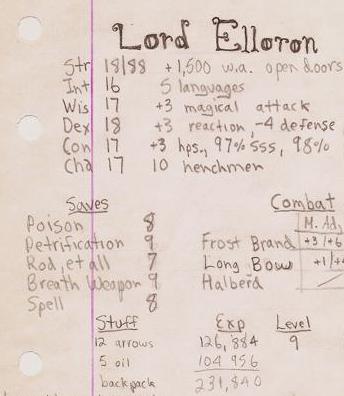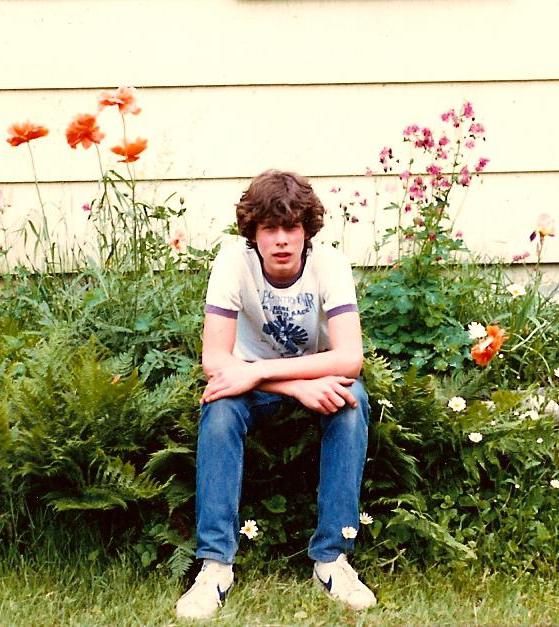
I have before me a sheet of three-hole lined notebook paper. Scrawled with pencil at the top of the page, in a flowery faux Gothic script, is this name: Lord Elloron. Stacked on the left side are the following characteristics — “Strength, Intelligence, Wisdom, Dexterity, Constitution, Charisma’’ — each assigned a number between 3 (low) and 18 (superhuman). This fellow has no number below 16.
He is Level 9 (high), with 99 hit points (a lot), an armor class of -2 (negative numbers are very good), and 231,840 experience points (insane). He wields a +2 Frost Brand and a +1 long bow, wears +1 plate mail, and owns a war horse, a giant falcon, and many magical items including a Gem of +3 Saves, Bracers of Shaken, and a Philter of Love.
Elloron, one of the more memorable “characters’’ I created in the 1980s, is a rock star, a superhero, a projection of my nerdy self’s need for power and agency. Even his name is a rip-off mash-up of “Aragorn’’ and “Elrond’’ from “The Lord of the Rings,’’ the fantasy novel I was obsessed with at the time. Which all makes sense, because this yellowed artifact from an arcane land can be carbon-dated to the time when my world was crumbling into chaos. When I most needed to feel heroic. When I needed to escape from myself into another realm.
This kingdom I refer to is Dungeons & Dragons, the original fantasy role-play game, which celebrates its 50th anniversary this year. I can now say, looking back, D&D saved my life.
I discovered the transmogrifying portal of D&D in 1979, when I was 11, the same year my mother returned from the hospital after an aneurysm ruptured in her brain at age 38. She survived, barely, having mutated into something only resembling the mother I knew and loved. She was now partially paralyzed, plagued by depression, prone to bizarre behavior, and no longer able to work, and she skulked through her days alone in the house while my siblings and I escaped to school. She had become, in my eyes, a doppelgänger, a demon, a zombie, the kind of shape-shifting foe I saw detailed in the D&D bestiary, the “Monster Manual.’’ I called her the Kitchen Dragon and sometimes, cruelly, behind her back, the Momster.
Ever since that year when everything changed, I’d been playing this new fantasy role-playing game obsessively each Friday night with my friends — as a Super 8 movie I shot in 1981 attests.
When I wasn’t playing D&D, I was thinking and dreaming about it, poring over hefty rule books like the “Dungeon Masters Guide,’’ sketching maps, designing underground complexes stocked with creatures, treasures, and traps, and rolling polyhedral dice to test my success and failure in the fantasy domains of my design.
D&D’s place in pop culture history is unique. Combining improvisational storytelling and number-crunching math and tactics, the game has its own special twist: The players, each playing a character such as a thief or a wizard, agree to be guided by a referee, a.k.a. the “Dungeon Master.’’ This DM is the arbiter of rules and chief narrator, and their main task is to lay the backstory of an imagined fantasy adventure — villains, quests, magic — whose confines are only limited by their imagination. A players asks, “I open the door into the tomb. What do I see?’’ and declares, “I zap the orc boss with my fireball spell.’’ The DM determines the outcome, usually by rolling dice.
The game is hardwired to create agency: What can I do? OK, I’ll do it.
You needn’t have suffered trauma to be a D&Der. There are other plenty of other reasons to play: for camaraderie, for kicks, for that sense of bigger-than-life adventure. But for me, the game became a safe haven into which I could pour all my insecurities, my anxieties, my fears. My dorky friends and I, raised on a steady diet of movies like “Star Wars,’’ “Raiders of the Lost Ark,’’ “Heavy Metal,’’ and “Monty Python and the Holy Grail,’’ could achieve feats and victories in the game that we could not pull off in our own lives. To a soundtrack of Blue Öyster Cult, Rush, and Led Zeppelin, we played paladins and wizards, warriors and crafty thieves. We overcame impossible odds and emerged victorious, again and again.
D&D’s influence cannot be overestimated. Every action video game that promises quest-based, outfit-your-avatar, level-up, kill-the-monster play — from Doom to Fortnight, The Oregon Trail to The Legend of Zelda — can trace its DNA back to D&D. In 1974, when Dungeons & Dragons made its debut as a humble homespun war game offshoot, its creators, Gary Gygax and Dave Arenson, could not have predicted its enduring impact on pop culture.
Nor could they have guessed its impact on withdrawn, insecure kids like me who were battling their own monsters at home.
My mother had fallen apart, my father was absent, and a variety of adults stepped in to raise me. Life had no rhyme or reason. D&D had rules with clear outcomes. I knew whether Lord Elloron needed to roll a 7 or 17 on a 20-sided die to save the villagers from hordes of goblins, or to slay evil wizards, or to solve the riddle that unlocked the cursed catacombs that revealed further treasure and clues. He’d level up again and again, and embark on the next chapter of his endless quest.
I might’ve fantasized: Mom, monster, Momster, I want to defeat you. I want to save you. I want to figure out how to love you. But my emotional intelligence was a 3. I could not articulate any of these desires, let alone pull off any of those quests.
Powerless in the real world, I needed a place to feel triumphant. I needed a win. D&D was not a bad place to retreat for a few years, to protect my psyche and fragile ego in a soft cushion of fantasy. D&D served me well. Protected me. Nurtured me. Gave me confidence. Stretched my imagination. Allowed me to tune out the real world, test my imaginary mettle, and wield real-feeling fantasy power.
The game has grown and changed since its pre-internet heyday, as all things pop culture do. These days, you can play online with people you’ve never met; D&D was a social lifeline for many during COVID. Shows like Netflix’s “Stranger Things’’ have brought D&D newfound popularity and respectability. Outed ex-nerds like Stephen Colbert and Anderson Cooper proudly proclaim the game’s influence on them in their formative years. As with competitive video gaming, watching professional D&D players on Twitch and YouTube has become a spectator sport. Teachers are using the game in classrooms to teach STEM and problem solving, and therapists tout its therapeutic magic for developing social skills among the neurodivergent and painfully unsocialized. Once feared that it would summon demons and suicidal thoughts among impressionable Reagan-era teens — remember the Satanic Panic? — D&D is now hailed by parents as a face-to-face antidote to excessive screen time. Parents have bigger worries, like PornHub, TikTok, and school shootings.
Fifty years on, I’m pleased that D&D and its oral storytelling, pen-paper-dice roots have endured, despite other technologies like video games and streaming TV that effortlessly deliver escapist entertainment. Now churning out a rules reboot, merchandise, and digital platforms to celebrate the game’s semicentennial, D&D’s parent company, Hasbro, has leveraged the game into a multimillion-dollar cash dragon. It has also smartly rebranded D&D as an inclusive, creative space for all races and identities — not just dwarves and elves. Like adjacent fantasy franchises such as Star Wars, Harry Potter, and Marvel, Dungeons & Dragons has assumed its rightful place in the nerd culture pantheon.
As a 57-year-old GenXer, I still play D&D on occasion. I never had to defeat my mother. She died in 1997.
Every so often, she appears to me when I sleep, sometimes dressed in white as a Gandalf-like wizard, offering advice. In a recent dream, I swear she told me, “Ethan. Put down your sword.’’
Ethan Gilsdorf , the author of “Fantasy Freaks and Gaming Geeks,’’ is working on his next book, “The Momster Manual: A Memoir Adventure.’’


